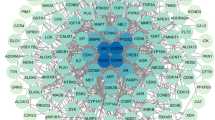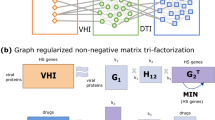Abstract
The existing anti-HIV-1 drugs have troublesome problems with side-effects and the development of drug resistance, etc. To avoid these problems by using our knowledge of complex network analyses, this study examines the topological conditions needed for a satisfactory anti-HIV-1 drug target, and suggests that a promising anti-HIV-1 drug target should be endowed with the features of a “hub” and a “bottleneck” in the HIV-1 proteins-intracellular agent interaction network.
Similar content being viewed by others
Explore related subjects
Discover the latest articles, news and stories from top researchers in related subjects.References
Horak GE, Luscombe NM, Qian J, et al (2002) Complex transcriptional circuitry at the G1/S transition in Saccharomyces cerevisiae. Genes Dev 16(23):3017–3033
Gavin AC, Bosche M, Krause R, et al (2002) Functional organization of the yeast proteome by systematic analysis of protein complexes. Nature 415:141–147
Yu H, Kim PM, Sprecher E, et al (2007) The importance of bottlenecks in protein networks: correlation with gene essentiality and expression dynamics. PLoS Comput Biol 3(4):e59:713–720
Hopkins AL (2008) Network pharmacology: the next paradigm in drug discovery. Nat Chem.Biol 4(11):682–690
Green WC, Peterlin BM (2008) Molecular biology of HIV: implications for new therapies. In: Volberding PA, Sande MA, Warner C, et al. (eds) Global HIV/AIDS medicine. Elsevier, Pennsylvania, pp 23–38
Okumura N, Hamaguchi M (2006) Careful points after HAART (in Japanese). Diagnosis Treatment 94(12):2255–2260
Author information
Authors and Affiliations
Corresponding author
Additional information
This work was presented in part at the 14th International Symposium on Artificial Life and Robotics, Oita, Japan, February 5–7, 2009
About this article
Cite this article
Harada, K., Ishida, Y. A hub gene in an HIV-1 gene regulatory network is a promising target for anti-HIV-1 drugs. Artif Life Robotics 14, 528–531 (2009). https://doi.org/10.1007/s10015-009-0735-5
Received:
Accepted:
Published:
Issue Date:
DOI: https://doi.org/10.1007/s10015-009-0735-5




